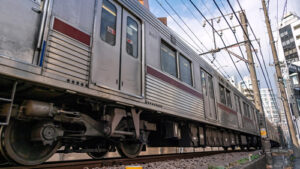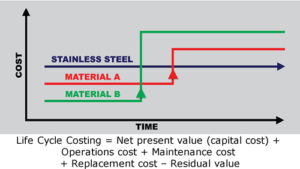- Perspective – July 2023
- Best of the GPS Newsletter
- Webinar Report Back
- State of the Nation
- Multi Alloys & EMV Africa
- Demand Drivers – SA Rail
- Fastenright Advert
- Africa Profile
- Technical Insight
- Grinding Techniques Advertorial
- Technical Insight
- Technical Insight
- Pferd SA Advert
- Passionate Professional Profile
- Obituary – John Cluett
- Staff News
- PtSA Member Visit
- Steel Summit
- KZN Golf Day 2023
- Columbus Mill Visit
SA RAIL INDUSTRY STRONGLY ADVISED TO EMBRACE STAINLESS STEEL AMIDST CRISIS

South Africa’s once proud 22 000km rail network, which historically accounted for 80% of Africa’s total rail infrastructure, is currently grappling with a dire crisis, which includes vandalism and the theft of existing infrastructure.
In response to this critical situation, Sassda member Columbus Stainless is taking significant strides to promote the use of stainless steel in the struggling rail sector. With the urgent need to revitalise the rail network, the company is actively bridging the knowledge gap among engineers and industry professionals.
Columbus Market Development Manager Lerato Mashigo says; “Reviving our once proudly South African rail freight network is of special significance, not only because it can streamline the stainless steel industry’s import and exports supply chains but also because it serves as a key demand sector for the supply of local stainless steel into strategic rail projects.”
Mashigo also emphasises the vital role of engineers and the need for them to be equipped with specialised knowledge of stainless steel for rail applications to allow for the selection of the right materials. The goal is therefore to cultivate a knowledgeable industry that recognises the inherent value of stainless steel and other viable alternatives.
She explains; “In light of this, we have identified a unique opportunity to advocate for the adoption of stainless steel in the rail sector by engaging with industry professionals and members of the South African Society of Railway Engineering (SASRE). We aim to provide tangible demonstrations of the advantages and benefits associated with using stainless steel in various rail-related projects.”
Significant investment required
 Speaking at a recent SASRE event, Mashigo, together with colleague Columbus Stainless Senior TCS & Product Quality Manager Helena Rossouw, emphasised the significance of investing in rail infrastructure. They proudly highlighted the local success and international recognition earned by the 3CR12 stainless steel grade, particularly in the rail and automotive industries. This robust stainless steel variant has gained considerable traction in the US market and played a pivotal role in the South African coal wagon industry, thanks to its exceptional corrosion (abrasion) resistance and impact strength.
Speaking at a recent SASRE event, Mashigo, together with colleague Columbus Stainless Senior TCS & Product Quality Manager Helena Rossouw, emphasised the significance of investing in rail infrastructure. They proudly highlighted the local success and international recognition earned by the 3CR12 stainless steel grade, particularly in the rail and automotive industries. This robust stainless steel variant has gained considerable traction in the US market and played a pivotal role in the South African coal wagon industry, thanks to its exceptional corrosion (abrasion) resistance and impact strength.
During the overview of the advantages of using stainless steel in rail applications, the all-women team from Columbus Stainless delved into the various families of stainless steel, providing practical examples of its superior performance compared to mild steel.
Rossouw points out, “3CR12 stainless steel has proven highly successful in coal handling applications, lasting over 30 years (and counting) without the need for additional maintenance or coating. In contrast, coal units made of mild steel require regular maintenance and coating, leading to frequent replacements.”
Minimal maintenance maximum benefits
This in turn highlights the significant advantage of stainless steel in terms of Life Cycle Costing, dispelling the common misperception around the upfront cost of stainless steel and the fact that mild steel is chosen over stainless steel based solely on initial cost.

“Many people tend to focus on the initial cost of the material without fully considering the associated maintenance and downtime expenses. Stainless steel emerges as a more economical choice when life cycle costs are thoroughly considered,” explains Rossouw.
To vividly illustrate the point, the presentation included a diagram that underscored the hidden costs incurred due to maintenance and production loss caused by downtime with mild steel. In stark contrast, stainless steel, with its self-repairing passive layer, eliminates the need for active maintenance and re-coating, making it a far more viable option in the long run.
Therefore, despite initial cost perceptions, stainless steel’s remarkable durability, corrosion resistance, and impact resistance position it as the superior choice for various rail applications. Furthermore, different grades of stainless steel cater to specific needs, making it an ideal material for transporting different media. For example, 304 stainless steel proves suitable for transporting water, while 316 stainless steel excels in transporting more corrosive media.
A critical juncture
The collaboration between Columbus Stainless and SASRE marks a significant turning point for South Africa’s rail industry which is at a critical juncture, facing challenges that demand immediate attention and innovative solutions.
Against this backdrop, Sassda Executive Director Michel Basson emphasises the long-term viability of stainless steel in South Africa’s flagging rail sector. “Amid South Africa’s pressing need to revive its ailing rail network, the rail industry’s collaboration with organisations like Columbus Stainless is considered a crucial step toward identifying sustainable solutions.
“Intensifying the awareness of the benefits of stainless steel will foster the growth of a knowledgeable and forward looking rail industry. With a steadfast focus on responsible and enduring investments, our industry can play a pivotal role in creating a resilient rail network poised to serve the country for generations to come” he concludes.
Additional Reading
1 www.citizen.co.za/news/r60-billion-crumbling-railnetwork
2 https://businesstech.co.za/news/government/676093/ ramaphosa-turns-his-attention-to-south-africasother- state-owned-crisis
3 www.reuters.com/world/africa/kumba-iron-ore-cutsoutput- forecast-south-africa-rail-crisis-2023-02-21
4. www.dailymaverick.co.za/article/2021-04-20-whatbroke- south-african-rail-and-can-it-be-fixed
5. https://www.transport.gov.za/rail#:~:text=Welcome%20 to%20Rail%20Branch,staff%20complement%20of%20 18%20207

